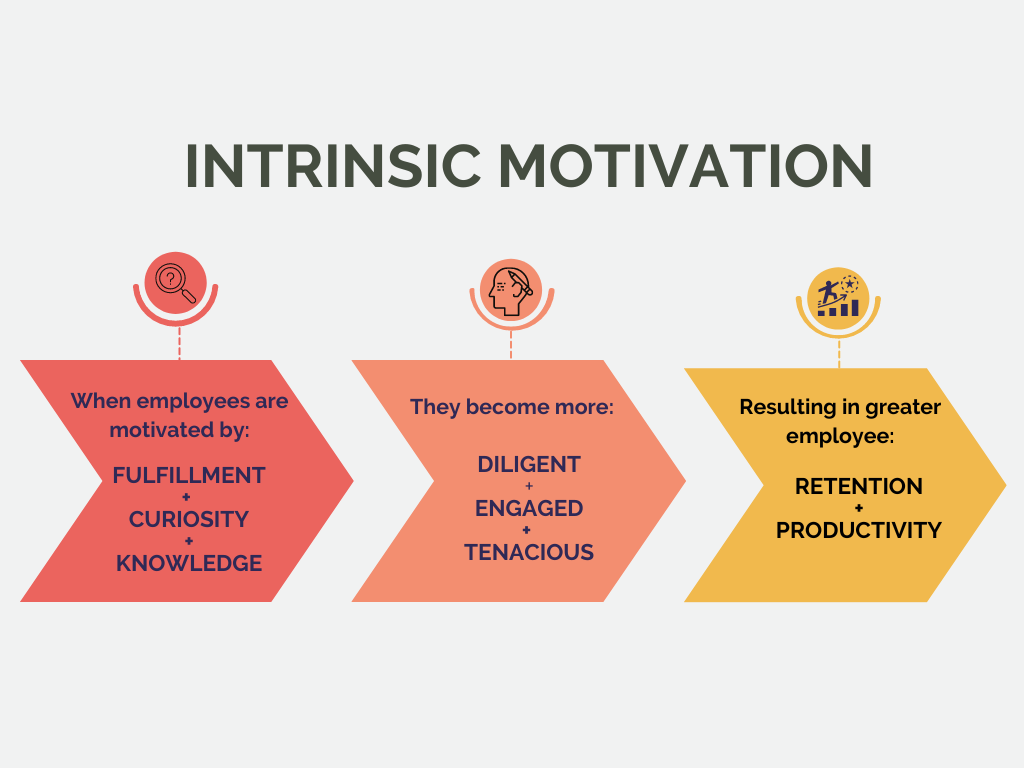Personal fulfillment vs. year-end bonuses.
Feeding curiosity vs. salary raises.
Pursuit of knowledge vs. job title promotions.
When an employee wakes up on a Monday morning to prepare for work, they are either motivated to perform their duties and start the week because of an internal reward (the examples in the first half of each line) or an external reward (the examples in the latter half).
As HR leaders, it is your responsibility to not only recognize the difference between the two types of motivation but also to work towards intrinsically motivating your employees.
Why intrinsic motivation? When employees are driven by fulfillment, curiosity, and knowledge, they are more diligent and engaged with their work—resulting in greater employee retention and productivity. In fact, highly engaged teams see 59% less turnover.

This blog aims to further break down the difference between intrinsic and extrinsic motivation and will uncover three tactics leaders can use to intrinsically motivate their employees.
Intrinsic vs. extrinsic motivation
Before we explore three tactics for how you can intrinsically motivate your employees, let’s first look at the contrast between intrinsic vs. extrinsic motivation:
Intrinsic Motivation
Employees are motivated to work based on the desire that comes from within. It could be because they find meaning in what they are doing/who they work for, are curious to learn something new, or have the aspiration to improve upon their current skills.
Simply put, intrinsically motivated employees feel more connected to their work and have a sense of pride attached to both their role and workplace. And this internal thinking that comes from intrinsically motivated employees has the power to lift your organization to higher levels of performance.
Extrinsic Motivation
Rather than the motivating factors that come from within, employees are motivated to do something because it leads to an outside reward—such as a bonus, salary increase, or a successful performance review.
While there is a place for extrinsic motivation (hard work should always be rewarded), extrinsically motivated employees don’t remain fulfilled long-term. When an employee gets a raise or a new job title, eventually, they will become dissatisfied with what they are receiving and leave your organization to pursue other opportunities.
How HR Leaders Can Intrinsically Motivate Employees
HR leaders want to see their employees engaged, motivated, and fulfilled in their roles—possessing an inner drive that sparks productivity and perseverance in a job. Additionally, these satisfied employees reduce an organization’s hiring costs (due to higher retention rates) and contribute to a positive workplace environment.
Leaders don’t have to take a Laissez-Faire approach, leaving employees to find motivation solely on their own. Rather, leaders can assist employees in finding that inner drive with these three strategies:
Execute an employee volunteer program
Purpose is about answering the question, “Why am I doing something and what is the intended result?” When employees perform a task at work, they subconsciously ask themselves this question.
HR leaders can instill a sense of purpose in their employees by introducing an employee volunteer program. Remember, although an employee’s primary purpose is to perform their assigned role, they can wear multiple hats—being both productive workers and community volunteers on company time.
With an employee volunteer program, leaders can encourage employees to find meaningful causes and offer their support to local communities during work hours. To ensure an employee volunteer program has high participation rates, issue four paid volunteer days per year.
Employees will quickly find that the purpose of volunteering is to help others in a selfless way, and they will feel like they are contributing to something greater than themselves. When employees can find purpose in community initiatives that are supported and encouraged by their leader(s), their devotion to their job will be enhanced.
Create a continuous learning environment
With the average retirement age being 66, coupled with the fact that most professionals enter the workforce after college or university in their early 20s, it is safe to say that one’s career can become stale.
However, continuing education in the form of seminars, courses, and workshops enables employees to learn new skills and knowledge—turning a stagnant career into one with an opportunity for growth and development.
For example, host a team-building workshop for specific departments within your organization—a workshop for marketing & sales, one for finance, one for engineering etc. These workshops not only foster a greater level of communication between team members of each department, but they can propel problem-solving and creative thinking.
The growth and development that stem from a continuous learning environment intrinsically motivates employees. They aren’t solely motivated to come to work because of a potential pay raise. They are motivated to show up each day because of a stimulating learning environment that can help them reach their full potential professionally.
Practice your company’s CSR mission
Your company’s CSR mission may be stated on your website, communicated in an interview, and briefly mentioned again when an employee onboards. After that, if your CSR mission isn’t practiced, it becomes a trophy—locked away in a glass case that remains on display but has no use beyond its show.
However, your CSR mission is an intrinsic motivator, empowering employees to take pride in the organization they work for. If your CSR mission is only displayed, employees who were once motivated to work for you (because they believed in your values) will become disengaged.
How can your CSR mission be practiced to intrinsically motivate your employees? By implementing company fundraiser days. Start by organizing a day for as many of your employees as possible to get out, give back, and enjoy quality time together as a team.
For example, if you are on a CSR mission to help build a better world, organize a company-wide fundraiser on behalf of a cause. A walk-a-thon, BBQ, or golf tournament are all creative ideas to raise money for a charity or nonprofit of your choice. With fundraisers, your employees aren’t only hearing about how you aim to build a better world; they are helping contribute to a better world.
Though intrinsic motivation refers to an employee’s internal desire to take action and reach a goal, leaders can step in and facilitate this motivation process. Intrinsically motivating your employees with these three out-of-the-box strategies will intensify the meaning, drive, and contentment that comes from within an employee—motivating them to perform their best every day.



